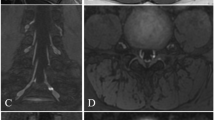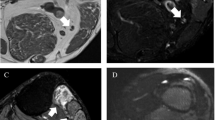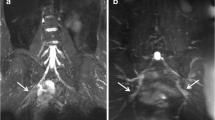Abstract
Objective
To assess the quality and accuracy of metal artifact reduction sequence (MARS) magnetic resonance imaging (MRI) for the diagnosis of lumbosacral neuropathies in patients with metallic implants in the pelvis.
Materials and methods
Twenty-two subjects with lumbosacral neuropathy following pelvic instrumentation underwent 1.5-T MARS MRI including optimized axial intermediate-weighted and STIR turbo spin echo sequences extending from L5 to the ischial tuberosity. Two readers graded the visibility of the lumbosacral trunk, sciatic, femoral, lateral femoral cutaneous, and obturator nerves and the nerve signal intensity of nerve, architecture, caliber, course, continuity, and skeletal muscle denervation. Clinical examination and electrodiagnostic studies were used as the standard of reference. Descriptive, agreement, and diagnostic performance statistics were applied.
Results
Lumbosacral plexus visibility on MARS MRI was good (4) or very good (3) in 92% of cases with 81% exact agreement and a Kendall’s W coefficient of 0.811. The obturator nerve at the obturator foramen and the sciatic nerve posterior to the acetabulum had the lowest visibility, with good or very good ratings in only 61% and 77% of cases respectively. The reader agreement for nerve abnormalities on MARS MRI was excellent, ranging from 95.5 to 100%. MARS MRI achieved a sensitivity of 86%, specificity of 67%, positive predictive value of 95%, and negative predictive value of 40%, and accuracy of 83% for the detection of neuropathy.
Conclusion
MARS MRI yields high image quality and diagnostic accuracy for the assessment of lumbosacral neuropathies in patients with metallic implants of the pelvis and hips.





Similar content being viewed by others
References
Fritz J, Lurie B, Miller TT, Potter HG. MR imaging of hip arthroplasty implants. Radiographics. 2014;34(4):E106–132.
Potter HG, Nestor BJ, Sofka CM, Ho ST, Peters LE, Salvati EA. Magnetic resonance imaging after total hip arthroplasty: evaluation of periprosthetic soft tissue. J Bone Joint Surg Am. 2004;86-A(9):1947–1954.
Hayter CL, Koff MF, Shah P, Koch KM, Miller TT, Potter HG. MRI after arthroplasty: comparison of MAVRIC and conventional fast spin-echo techniques. AJR Am J Roentgenol. 2011;197:W405–11.
Hayter CL, Koff MF, Potter HG. Magnetic resonance imaging of the postoperative hip. J Magn Reson Imaging. 2012;35:1013–25.
Burge AJ, Gold SL, Kuong S, Potter HG. High-resolution magnetic resonance imaging of the lower extremity nerves. Neuroimaging Clin N Am. 2014;24(1):151–70.
Fritz J, Ahlawat S, Demehri S, Thawait GK, Raithel E, Gilson WD, et al. 8-fold accelerated high resolution metal artifact reduction MRI of cobalt-chromium knee arthroplasty implants. Invest Radiol. 2016;51(10):666–76.
Fritz J, Fritz B, Thawait GK, Raithel E, Gilson WD, Nittka M, et al. Advanced metal artifact reduction MRI of metal-on-metal hip resurfacing arthroplasty implants: compressed sensing acceleration enables the time-neutral use of SEMAC. Skeletal Radiol. 2016;45(10):1345–56.
Ulbrich EJ, Sutter R, Aguiar RF, Nittka M, Pfirrmann CW. STIR sequence with increased receiver bandwidth of the inversion pulse for reduction of metallic artifacts. AJR Am J Roentgenol. 2012;199(6):W735–42.
Sutter R, Ulbrich EJ, Jellus V, Nittka M, Pfirrmann CW. Reduction of metal artifacts in patients with total hip arthroplasty with slice-encoding metal artifact correction and view-angle tilting MR imaging. Radiology. 2012;265:204–14.
Muller GM, Lundin B, von Schewelov T, Muller MF, Ekberg O, Mansson S. Evaluation of metal artifacts in clinical MR images of patients with total hip arthroplasty using different metal artifact reducing sequences. Skeletal Radiol. 2015;44:353–9.
Wolf M, Bäumer P, Pedro M, Dombert T, Staub F, et al. Sciatic nerve injury related to hip replacement surgery: imaging detection by MR neurography despite susceptibility artifacts. PLoS One. 2014;92:e89154.
DeHart MM, Riley Jr LH. Nerve injuries in total hip arthroplasty. J Am Acad Orthop Surg. 1999;72:101–11.
Chhabra A, Belzberg AJ, Rosson GD, Thawait GK, Chalian M, Farahani SJ, et al. Impact of high resolution 3 tesla MR neurography (MRN) on diagnostic thinking and therapeutic patient management. Eur Radiol. 2016;265:1235–44.
Chhabra A, Chalian M, Soldatos T, Andreisek G, Faridian-Aragh N, Williams E, et al. 3-T high-resolution MR neurography of sciatic neuropathy. AJR Am J Roentgenol. 1984;2012:W357–64.
Kwee RM, Chhabra A, Wang KC, Marker DR, Carrino JA. Accuracy of MRI in diagnosing peripheral nerve disease: a systematic review of the literature. AJR Am J Roentgenol. 2014;203:1303–9.
Chhabra A, Rozen S, Scott K. Three-dimensional MR neurography of the lumbosacral plexus. Semin Musculoskelet Radiol. 2015;192:149–59.
Soldatos T, Andreisek G, Thawait GK, Guggenberger R, Williams EH, Carrino JA, et al. High-resolution 3-T MR neurography of the lumbosacral plexus. Radiographics. 2013;33:967–87.
Andreisek G, Crook DW, Burg D, Borut M, Weishaupt D. Peripheral neuropathies of the median, radial, and ulnar nerves: MR imaging features. Radiographics. 2006;26:1267–87.
Fritz J, Fritz B, Thawait GG, Meyer H, Gilson WD, Raithel E. Three-dimensional CAIPIRINHA SPACE TSE for 5-minute high-resolution MRI of the knee. Invest Radiol Invest Radiol. 2016;51(10):609–17.
Ahlawat S, Belzberg AJ, Montgomery EA, Fayad LM. MRI features of peripheral traumatic neuromas. Eur Radiol. 2016;26:1204–12.
Brown GD, Swanson EA, Nercessian OA. Neurologic injuries after total hip arthroplasty. Am J Orthop. 2008;374:191–7.
Farrell CM, Springer BD, Haidukewych GJ, Morrey BF. Motor nerve palsy following primary total hip arthroplasty. J Bone Joint Surg Am. 2005;87(12):2619–25.
Navarro RA, Schalzried TO, Amstutz HC, Dorey FJ. Surgical approach and nerve palsy in total hip arthroplasty. J Arthroplasty. 1995;10:1–5.
Zappe B, Glauser PM, Majewski M, Stöckli HR, Ochsner PE. Long-term prognosis of nerve palsy after total hip arthroplasty: results of two-year-follow-ups and long-term results after a mean time of 8 years. Arch Orthop Trauma Surg. 2014;134:1477–82.
Schmalzried TP, Amstutz HC, Dorey FJ. Nerve palsy associated with total hip replacement. Risk factors and prognosis. J Bone Joint Surg Am. 1991;73:1074–80.
Melamed NB, Satya-Murti S. Obturator neuropathy after total hip replacement. Ann Neurol. 1983;13:578–9.
Weber ER, Daube JR, Coventry MF. Peripheral neuropathies associated with total hip arthroplasty. J Bone Joint Surg [Am]. 1976;58:66–9.
Edwards BN, Tullos HS, Noble PC. Contributory factors and etiology of sciatic nerve palsy in total hip arthroplasty. Clin Orthop 1987;(218):136.
Pfirrmann CW, Notzli HP, Dora C, Hodler J, Zanetti M. Abductor tendons and muscles assessed at MR imaging after total hip arthroplasty in asymptomatic and symptomatic patients. Radiology. 2005;235:969–76.
Author information
Authors and Affiliations
Corresponding author
Ethics declarations
Ethical approval
All procedures performed in studies involving human participants were in accordance with the ethical standards of the institutional and/or national research committee and with the 1964 Declaration of Helsinki and its later amendments, or comparable ethical standards.
Grant support
There was no grand support for this study.
Conflicts of interest
Jan Fritz received institutional research funds and a speaker’s honorarium from Siemens Healthcare USA and is a scientific advisor of Siemens Healthcare USA and Alexion Pharmaceuticals, Inc.
The other authors declare that they have no conflicts of interest.
Rights and permissions
About this article
Cite this article
Ahlawat, S., Stern, S.E., Belzberg, A.J. et al. High-resolution metal artifact reduction MR imaging of the lumbosacral plexus in patients with metallic implants. Skeletal Radiol 46, 897–908 (2017). https://doi.org/10.1007/s00256-017-2630-9
Received:
Revised:
Accepted:
Published:
Issue Date:
DOI: https://doi.org/10.1007/s00256-017-2630-9




